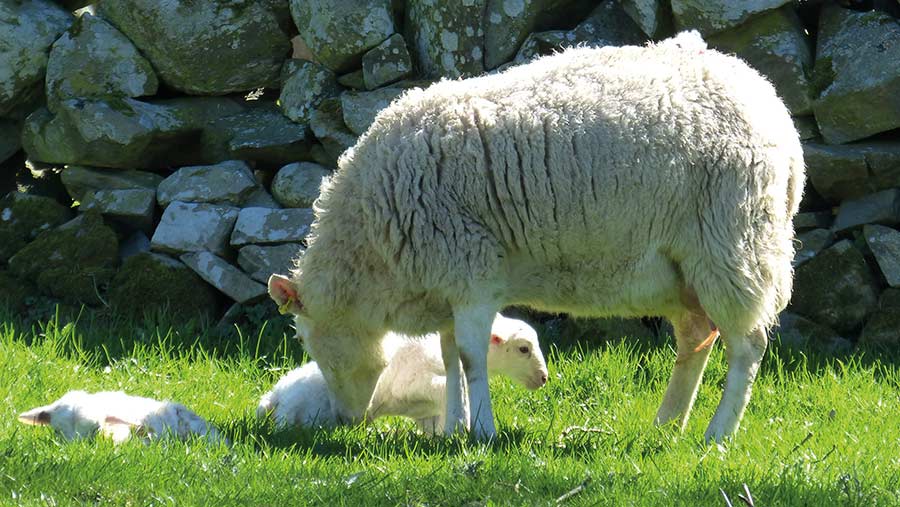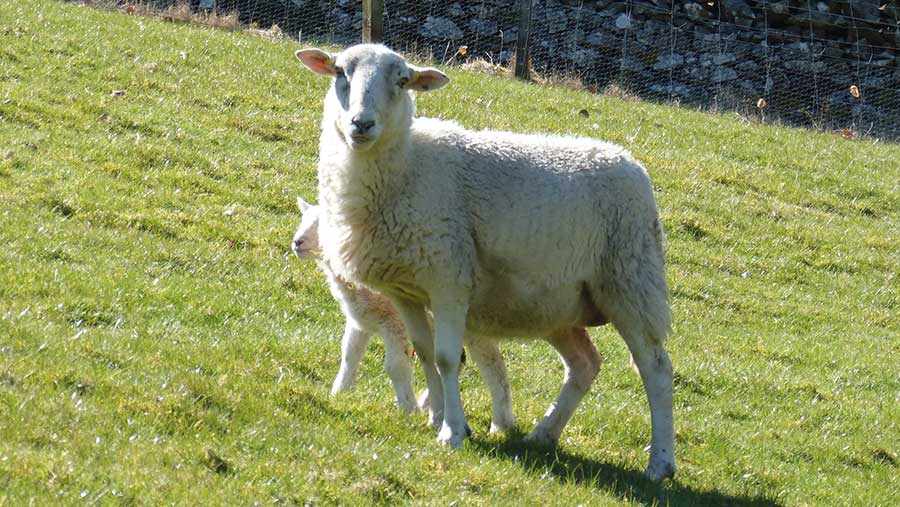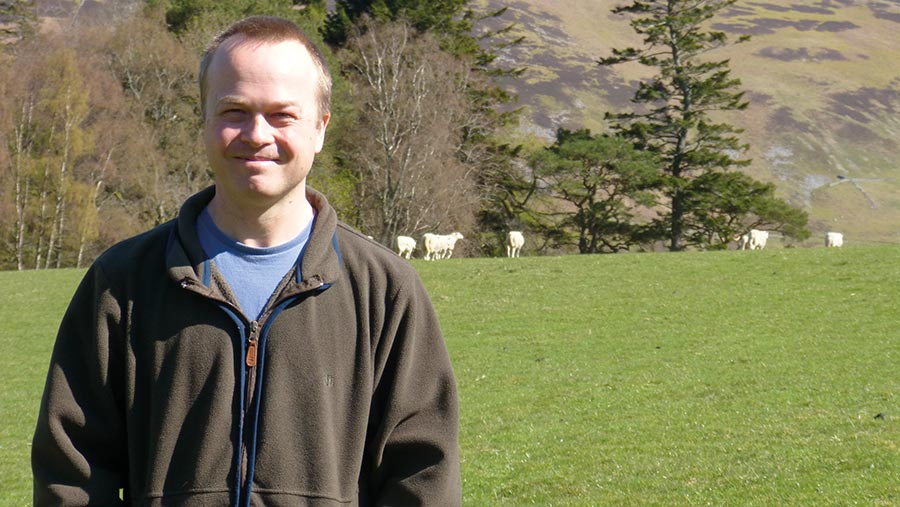Four reasons Scottish wool shedders are good fit for NZ
 A shearling lambing her twins outdoors © MAG/Michael Priestley
A shearling lambing her twins outdoors © MAG/Michael Priestley A trailblazing hill farm’s maternal selection policy and commercial focus on its wool-shedding ewes has attracted the attention of a world-leading sheep stud.
The Welsh family of Mossfennan, near Biggar, sent their second batch of genetics to Wairere Romneys of New Zealand last autumn.
See also: Upland beef and sheep farm aims for 30-hour week
The renowned North Island operation is diversifying into wool shedders to help manage labour costs.
Four other Easycare flocks (Barry Sangster, Campbell Tweed, Steven Johnston and Hayden Woolley) have been trialled by Wairere, which is seeking genetics from sheep breeders who “run sheep like cattle”.
Farmers Weekly spoke to Wairere and the Welshes to find out why Mossfennan was deemed a good fit for New Zealand’s foray into shedding genetics.
Farm facts: Mossfennan
- 700 Easycare-cross ewes
- 250 hoggs and 60 tup hoggs
- 500ha (1,235 acres) effective
- 100ha (247 acres) of commercial Sitka spruce
- Selling about 20 shearling rams a year
- 100ha (247 acres) of in-bye grass, of which half can be reseeded
- Reseeding about 4ha (10 acres) a year
- Prime stock and 100-150 store lambs sold through Farmstock
- Monitoring iceberg diseases with Glasgow Vet School
1. Maternal system
Like the other Easycare breeders working with Wairere, Sandy and Ann Welsh and son Tom prioritise ewes that show maternal ability in a challenging environment to minimise intervention and labour.
They employ a part-time shepherd, who counts as a full-time labour unit at lambing, with Sandy, Ann and son Tom counting as half a labour unit. Tom is a full-time shift-working engineer for Network Rail, and Sandy and Ann are semi-retired.
The flock used to number 1,000 head, and, along with a contract flock across the Tweed valley, Tom managed about 2,000 ewes using family labour, in a low-intervention system.
However, the flock now numbers about 720 head and 250 hoggs, split three ways:
- A flock: 350 performance-recorded elite ewes split across six families – previously old hefts, which have been selected from a recorded flock of 800 ewes
- B flock: A second tier flock of about 100 ewes. These may be lower-index spares left over from the elite flock, as the single sire mating groups of 50-60 ewes can produce more replacements than required. This mob is bred to an Easycare and some ewe lambs are kept and sold from this flock
- C flock: Terminal sire mob of about 250 ewes. Any ewes failing to make the grade are put to a terminal sire. Ewes are generally culled on age at five crops.
Ewes lamb outside from 20 April for two cycles, with 90% lambing in the first cycle. The farm has 12 lambing pens (called “casualty pens”). Sheep are lambed in bye and checked twice a day.

© MAG/Michael Priestley
To make the grade for breeding, a female must:
- Lamb outside unassisted as a shearling (only 1% of ewes on the whole farm need assistance)
- Need no help rearing its lamb
- Avoid the attention of the shepherd all year (no lameness or flystrike)
- Be above average on index, including estimated breeding values (EBVs) for body condition score and worm resistance
- Be dag-free and shed all their wool.
2. Depth of recording
A legacy of almost 40 years of performance recording was another attraction of Mossfennan genetics. Sandy and Ann were founding members of a group of Scottish Blackface breeders who started Signet recording in 1986.
However, their need for maternal traits such as lamb survival and health traits including parasite resistance forced them down the route of the New Zealand-based genetic evaluation service SIL (Sheep Improvement Ltd) in 2010.
“Signet now offers much of what we were after,” explains Ann. “The UK system has come on in leaps and bounds since.”
In 2010, after two years of trialling Easycare rams on two hefts, they stopped using Blackface tups. The heft system has since been discontinued and the hill subdivided.
Retained rams have shed completely since 2013 and the elite flock since 2019. About 40 partially shed ewes were shorn last year in the terminal flock.

Tom Welsh © MAG/Michael Priestley
3. Raising the bar
The flock is continually challenged to improve, for example:
- 2004: Faecal egg counts were monitored to influence worming and breeding decisions
- 2012: Recurrent lameness had always been a culling offence, but after two summers of culling following formalin footbaths at weaning, it became a zero-chance offence. About half the limping sheep were cured and the rest were marked and culled. Now 1-2% are culled for lameness each year
- 2015: A strict terminal sire drafting flock was created to weed out poor performers
- Today: Ewes that have “sweaty” lambs that attract parasites or have issues with flystrike are drafted out of the A flock.
4. New Zealand data
Recording on the New Zealand SIL system since 2010 means Wairere understands the Mossfennan flock’s performance, as the EBV weighting and index are the same.
A Wairere spokesperson says this increases faith in the flock. Mossfennan leased four tups to Wairere in 2021 and five in 2022 for semen harvesting.
Wairere has also implanted close to 300 embryos from 40 ewes leased this year.
“It’s exciting to think we could have genetic linkage with New Zealand and compare our sheep,” explains Tom. “SIL has only benchmarked our own sheep so far.”
Management at Mossfennan
Thin peaty gley soil over rock often means spring arrives late at Mossfennan.
Single-bearing ewes winter on the hill, while twins are housed at scanning in late February and fed haylage before being turned outside on grass alone in early April, two weeks before lambing.
After lambing and tagging, the A flock is sent to the heather hill and 200 bales of silage are made.
A little concentrate is used to meet maintenance requirements, as the farm is cold and gets 1,200-1,500mm of rain a year. This winter, 10t of blocks and 15t of ewe rolls were used.
“We’ve grown decent kale, brassica and turnip crops, but each time they’ve been ruined either by -13C frosts, heavy snow or flooding,” says Tom.
Ticks are an issue, so ewes and lambs are treated as they go out to the hill in spring.
However, labour is saved on never having to dag or crutch sheep – only the occasional lamb needs cleaning up before going to slaughter.
Why is Wairere interested in shedders?
Labour laws
A strict 38-hour week with time off in lieu and overtime pay is in force in Australia, meaning farmers there are keen to cut costs.
Labour costs
Shearing contract cost (including wrappers and catering) is £5 a ewe for crossbreds.
Wairere estimates a net wool cost of £34,000 across a New Zealand flock of 3,500 ewes when accounting for shearing, fly strike, treatments and time.
Trend for “nudies”
Conventional Romneys remain the keystone of Wairere’s genetic offering and 95% of its business, but a trend for shedding in Australia and the growth of Dorpers and other hair-type sheep has been noticed. Canadian and US farmers are also interested.
Commercial interest
- Wairere sold 90 rams in New Zealand last year from the first UK import
- They averaged about £2,250, selling at £1,200-£4,200
- Two commercial farms spent more than £20,000 on wool-shedding rams
Source: Pierre Syben, Wairere Romneys
